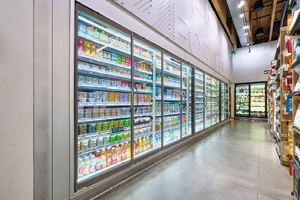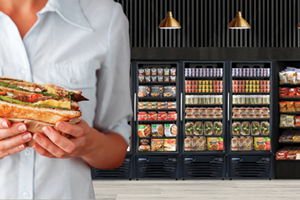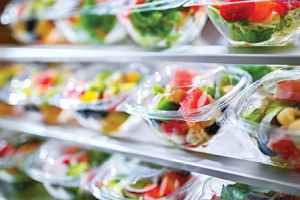From packaged beverages to grab-and-go food, a good bulk of the products sold in c-stores reside in refrigerated merchandisers. Packaged beverages make up a big share of inside merchandise sales (17.96%), while commissary foodservice items are also growing in dollar sales per store (up 6.7% from 2022 to $6,224 on average per store, per month) according to the NACS State of the Industry Report® of 2023 Data.
The banks of walk-in coolers and cold vaults along the store walls have long been a staple of c-stores, but even this tried-and-true category is seeing innovations. Today’s merchandisers can do much more than just keep products cold.
“LED lights deliver brilliant illumination for products while using less energy than fluorescent fixtures.”
Branding, too, plays an important role in grabbing customers’ attention and maintaining their loyalty. Refrigerated merchandisers have a lot of real estate for logos and signage, or even just colors to enhance your store’s brand.
Improving the Tried-and-True Bank of Merchandisers
Packaged beverages are a driving force within c-stores, coming in as a top performing category for inside merchandise sales.
Getting product out in front of customers is key to sustaining and growing sales. Products such as True Manufacturing’s Contemporary Visual Merchandiser (CVM) and Anthony’s Infinity Max are two new lines of merchandisers with doors engineered to have more glass surface to show off more product. The CVM’s curved edge design helps improve the visual field and the cabinets also have space for more product than its traditional counterpart, the company says. Anthony’s Infinity Max is designed with minimal rails that could otherwise impair visibility, while using standard glass packs for durability.
 The Infinity Max from Anthony
The Infinity Max from Anthony
Manufacturers have paid attention to interior design as well. “An emerging trend involves using black material for the interior of coolers, enhancing the vibrancy of the displayed product,” said Randy Skyba, vice president of sales and marketing, Due North. Adding colorful LED lighting to that black interior can also make displays stand out better.
“LED lights deliver brilliant illumination for products while using less energy than fluorescent fixtures,” Skyba said. They can also be added as strips to each shelf, so offer more flexibility.
Flexibility and Customization
Shelving can provide flexibility for drinks of different categories and sizes. Marmon said its new Ice-Glide is a completely customizable shelving system with snap-on components that can not only be set to fit any size bottle or can, the shelves are also easy to remove and clean in the case of a spill.
Temperature is another area where flexibility comes into play, especially for operators with limited space. Retailers might want the ability to stock pints of ice cream in a cooler door one week and switch over to energy drinks for an LTO the next week. The FlexTemp line of merchandisers from True Manufacturing has the ability to go from refrigerator to freezer at the flip of a switch, with a temperature range from 38 degrees to -10.
“With limited staff it’s inconvenient and time consuming to have to come around the counter to unlock a merchandiser.”
Aside from the perimeter coolers, standalone refrigeration units placed strategically throughout the store can help drive sales. Standalone units come in a variety of sizes and can be put virtually anywhere in the store, encouraging impulse buys at the register or other high-traffic areas.
Manufacturers are helping operators make these units stand out and attract attention by adding a slew of colors options and branding capabilities to their product lines. Beverage-Air and True Manufacturing offer a powder coat option that comes in a slew of colors and can be customized. True Manufacturing also offers some automotive paint options for a pearl sheen, and Beverage-Air amps up the customization to include logos and artwork printed on a vinyl wrap and applied to the merchandiser.
“We’ve seen the grab-and-go concept in c-stores for a long time … but many operators are self-branding products and putting it in their own packaging. Having this reinforced on the merchandiser only helps grow customer loyalty,” said Todd Lindsay, vice president of strategic accounts, Dover Food Retail.
For a different kind of flexibility, some companies, such as Polar King, offer refrigeration units for outside the store. Polar King offers both coolers and freezers engineered for outdoor use.
Merchandising Without Doors
As grab-and-go packaged food grows, open-air refrigerated merchandisers play a role in getting those products front and center. Whether it’s a horizontal or vertical case or a shop-around island, there’s something appealingly easy about reaching in for product without having the barrier of a door—which can subtly spur customers to pick up more merchandise.
 A glass door merchandiser from Due North
A glass door merchandiser from Due North
“These cases allow retailers to creatively and skillfully merchandise prepared food items for all dayparts, from breakfast to snacking, all in one area,” said Marjorie Proctor, senior marketing and design manager, Hillphoenix.
For operators looking to take advantage of branding and customization on open-air coolers, horizontal and vertical cases have the same options for colors and signage as their door-laden counterparts. Many come with retractable screens that can be pulled up at night, or the choice to upgrade to sliding doors that lock. Island merchandisers that customers can walk around provide even greater flexibility in placement.
Highlighting Security
Shrink and loss prevention are issues every retailer deals with, and refrigerated merchandisers aren’t immune to this challenge, whether it’s from theft, power outages or other unforeseen circumstances. Some innovative technologies on refrigerated merchandisers are attempting to reduce this risk.
Due North offers SmartLock and SmartConnect technologies on its Minus Forty product lines. The SmartLock monitors the interior temperature of the equipment and locks the door if the cooler gets warm or breaks down, preventing access to the products inside until the operator can inspect the food and dispose it if necessary. The SmartConnect feature uses the Internet of Things (IoT) to allow operators to monitor temperatures in real time and get notifications if a door is left open or the unit exceeds the set temperature.
 A grab-and-go merchandiser from Due North
A grab-and-go merchandiser from Due North
Modern Store Equipment’s Secure Cooler seeks to deter shoplifting of high-theft food and drink items. The locking system is completely invisible to the end user and can be controlled with a timer, an app or with the push of a button behind the manager’s counter.
“We know there are items that operators would like to limit access to, but with limited staff it’s inconvenient and time consuming to have to come around the counter to unlock a merchandiser,” said Will Steinmann, president, Modern Store Equipment. “Our security system provides an option for people who want to minimize loss and can be retrofitted on a variety of merchandisers.”
Anthony has also answered the need for more security with its Kodiak Automatic Beer Cave doors. “The beer cave is a frequently shopped location at the c-store, and putting locks on those doors came across as not customer-friendly,” Lindsay said. “Our project allows for remote locking with a switch behind the counter for any clerk to provide access.”
Environmentally Friendly Refrigerants
When you start shopping around for refrigerated merchandisers, you’ll more than likely see manufacturers listing the use of R290. This refrigerant is replacing hydrofluorocarbon refrigerants (HFCs) that have a much higher Global Warming Potential (GWP).
The switch is being aided in part by the American Innovation and Manufacturing (AIM) Act of 2020, which authorized the EPA to address HFCs by providing regulations and guidance in phasing down the production and consumption of listed HFCs, manage the HFCs and their substitutes and facilitate the transition to next-generation technologies through sector-based restrictions.
Manufacturers will no longer be able to use high GWP HFCs in standalone refrigeration after January 1, 2025, and all retail food equipment by January 1, 2026.
For c-store operators, the equipment in stores will not need to be replaced just because of the mandate. But as the switchover gains momentum, prices of HFC refrigerants will increase and availability will become more scarce, making maintenance and repair more challenging.